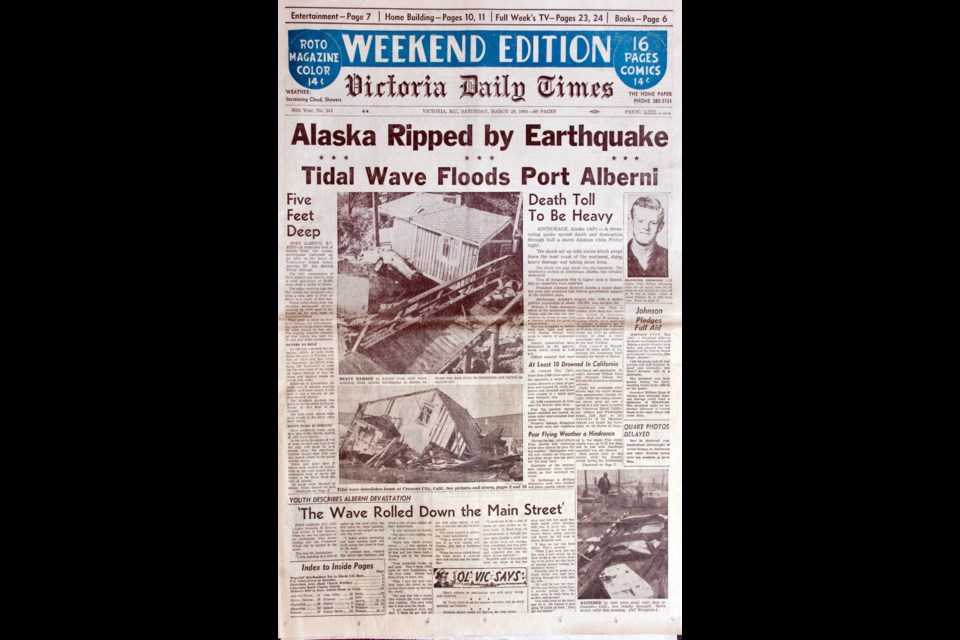Friday, March 28 marks the 50th anniversary of the 1964 tsunami that hit Port Alberni, a monumental event that somehow left everyone in its wake alive.
The surge of water, propelled by the funnel effect through narrow Alberni Inlet, grew from a 9.2-magnitude earthquake in Alaska. It reached Port Alberni just after midnight.
Cars were lifted up and buildings shifted on their foundations. Former Port Alberni mayor Ken McRae, a 19-year-old mill worker at the time, said one of the worst things was all of the logs strewn around after coming loose from their booms. “They were everywhere.”
There was no warning system in place, but people banded together and managed to stay out of harm’s way.
“No one was killed,” McRae said. “That was the main thing.”
With the Port Alberni tsunami as a backdrop, Emergency Management B.C. has organized a “road show” around Vancouver Island to spread the message of disaster awareness and preparation. Earthquakes and tsunamis are among the topics covered by Alison Bird, a Natural Resources Canada seismologist, or earthquake expert, and others.
Sessions began March 11 in Oak Bay, went to Central Saanich and Sooke last week, and wind up Saturday in Zeballos.
A Thursday session in Port Alberni will include a remembrance of the 1964 tsunami, and the city will also have a number of other gatherings to mark the occasion.
Eleven presentations in all will be made in Island communities. Forums were held on B.C.’s north coast last November and on Haida Gwaii last month.
“We’re just really keen on getting people aware of the hazards — the earthquake, the tsunami — how to respond, how to prepare,” said Bird, who works out of the Natural Resources Canada facility in North Saanich.
Preparing for a disaster begins with individual knowledge, she said.
“That is probably the most important part because it really does come down to the individual. There certainly aren’t enough government resources even if you bring all the different levels of government together in order to help everyone after an event.”
But there is certainly strength in numbers. Bird has an emergency plan with a neighbour so they can combine resources.
“That sort of thing goes a long way,” she said.
Bird said that being ready for a disaster comes with the territory in her line of work.
“I don’t think I could do what I do and not be prepared,” she said. “I wouldn’t be able to feel confident in my life in general, knowing what I know. I think of earthquakes and tsunamis every day.”
Bird is part of a team that processes earthquake data for western Canada.
“We usually locate about 4,000 every year of varying magnitude. But the number of earthquakes being recorded has gone up dramatically over the last two years just because of the number of aftershocks from the 2012 event.”
That quake had a magnitude of 7.7 and was centred off the coast of B.C. in Haida Gwaii, also known as the Queen Charlotte Islands. The resulting tsunami was the largest one in the world that year, Bird said.
“It was a very focused tsunami, so it certainly hit the west coast of Moresby Island [in Haida Gwaii] and it hit part of Hawaii.”
People in Hawaii fled to higher ground, but the tsunami had little effect.
Bird noted that Natural Resources Canada is working with the University of Victoria-based NEPTUNE project — an extensive subsurface array of cables that collects ocean data — to develop an early-warning system for tsunamis.
“We’re players in that, one of the stakeholders,” she said. “It’s a very exciting initiative.”
Bird said preparing for an emergency involves basic messages that always bear repeating.
“I do start to feel a bit of a nag,” she said. “But it’s only because I’m so eager that people are aware of the hazards, that they do prepare for them and they do respond properly.”
Tried-and-true advice is often the best, Bird said.
“For earthquakes, it’s ‘drop, cover and hold on.’ We can’t stress enough. Really, it’s the best thing to do,” she said.
“And then when the shaking stops and you know things are settled, if you’re in an area that is at risk [for a tsunami], then get to higher ground.”
That includes the Victoria area, as well as the open coastline around Sooke and Port Renfrew.



